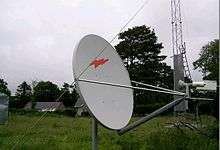Block upconverter

1.2 Andrew dish assembly
| Part of a series on |
| Antennas |
|---|
 |
|
Common types |
|
Radiation sources / regions |
A block upconverter (BUC) is used in the transmission (uplink) of satellite signals. It converts a band of frequencies from a lower frequency to a higher frequency. Modern BUCs convert from the L band to Ku band, C band and Ka band. Older BUCs convert from a 70 MHz intermediate frequency (IF) to Ku band or C band.
Most BUCs use phase-locked loop local oscillators and require an external 10 MHz frequency reference to maintain the correct transmit frequency.
BUCs used in remote locations are often 2 or 4 W in the Ku band and 5 W in the C band. The 10 MHz reference frequency is usually sent on the same feedline as the main carrier. Many smaller BUCs also get their direct current (DC) over the feedline, using an internal DC block.
BUCs are generally used in conjunction with low-noise block converters (LNB). The BUC, being an up-converting device, makes up the "transmit" side of the system, while the LNB is the down-converting device and makes up the "receive" side. An example of a system utilizing both a BUC and an LNB is a VSAT system, used for bidirectional Internet access via satellite.
The block upconverter is a block shaped device assembled with the LNB in association with an OMT, orthogonal mode transducer to the feed-horn that faces the reflector parabolic dish. This is opposed to other types of frequency upconverter which may be rack mounted indoors or not co-located with the dish.
Training
VSAT specific training that demonstrates the use of the block upconverter:
External links
- VSAT Installation Manual with explanation of the block upconverter
- Swedish microwave LNB
- Terrasat Communications Ground Breaking IBUC

